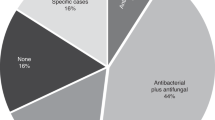Abstract
A group of 51 patients with multiple myeloma, non-Hodgkin’s lymphoma or Hodgkin’s disease receiving high-dose chemotherapy and autologous peripheral blood stem cell rescue received chemotherapy and clinical care in the peritransplant period at home. This group was compared with 88 cases with the same diagnoses, receiving the peripheral stem cell transplant over the same time period as an inpatient in a high efficiency particulate air filtered bone marrow transplant unit. Patients were treated at home based on choice, geographic accessibility, availability of an educated care giver and a clean home environment, and comprehension of the concepts of infection and aseptic techniques. Febrile neutropenia and sepsis were not increased in the home group and no episodes of septic shock were seen in this group. Patients at home received prophylactic oral ciprofloxacin and roxithromycin during the phase when the absolute neutrophil count was <1 × 109/l. Fewer gram-negative infections, but no diminution in gram-positive infections or in the rate of fever were seen in patients at home. Empiric therapy with a third generation cephalosporin, teicoplanin and tobramycin was instituted in 31 patients who developed a fever greater than 38.5°C. Of this group of 31, 18 required admission to hospital, 12 because of febrile neutropenia which persisted or was considered unsuitable for management at home due to sepsis. The remaining 13 with febrile neutropenia remained at home throughout, as did the 20 cases not developing neutropenic fever. This study demonstrates the feasibility of managing carefully selected patients in their home environment when at risk from febrile neutropenia or other septic complications following autologous peripheral stem cell support.
This is a preview of subscription content, access via your institution
Access options
Subscribe to this journal
Receive 12 print issues and online access
$259.00 per year
only $21.58 per issue
Buy this article
- Purchase on Springer Link
- Instant access to full article PDF
Prices may be subject to local taxes which are calculated during checkout
Similar content being viewed by others
Author information
Authors and Affiliations
Rights and permissions
About this article
Cite this article
Herrmann, R., Trent, M., Cooney, J. et al. Infections in patients managed at home during autologous stem cell transplantation for lymphoma and multiple myeloma. Bone Marrow Transplant 24, 1213–1217 (1999). https://doi.org/10.1038/sj.bmt.1702044
Received:
Accepted:
Published:
Issue Date:
DOI: https://doi.org/10.1038/sj.bmt.1702044
Keywords
This article is cited by
-
Comparison of chemotherapy treatment administration via venous port and peripheral vascular access in terms of quality of life and costs
Quality of Life Research (2023)
-
Low circulating mannan-binding lectin levels correlate with increased frequency and severity of febrile episodes in myeloma patients who undergo ASCT and do not receive antibiotic prophylaxis
Bone Marrow Transplantation (2017)
-
The role of prophylactic antimicrobials during autologous stem cell transplantation: a single-center experience
European Journal of Clinical Microbiology & Infectious Diseases (2012)
-
Feasibility and obstacles in home chemotherapy for malignant lymphoma
International Journal of Hematology (2007)
-
Autologous hematopoietic stem cell transplants that utilize total body irradiation can safely be carried out entirely on an outpatient basis
Bone Marrow Transplantation (2006)



